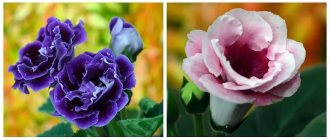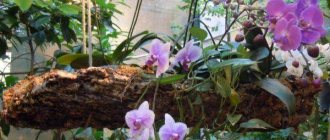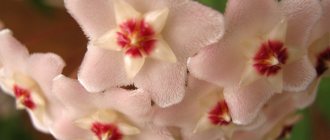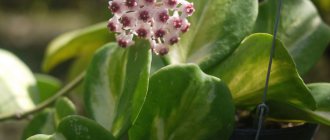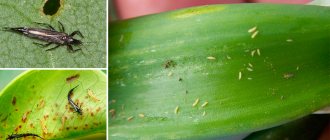Three plant groups
- Unifoliate . These species have one large, constantly growing leaf, which is actually a cotyledon. This leaf reaches almost a meter in length! Several flower stalks appear in the second year. This plant blooms once and then dies. Rarely found in home collections.
- Polyfolia . This is a plant with a stem and leaves, from the axils of which several flower stalks grow. Such streptocarpus are usually short and come in ampelous forms. Like the first type, it is not very common as a houseplant.
- Rosette streptocarpus . They are the ones who confidently lead as inhabitants of home window sills. These plants, without stems, form rosettes like their relatives, Saintpaulias. They bloom profusely and lend themselves well to hybridization. Thanks to this, they have won well-deserved love and steadily growing popularity.
Rosette varieties, which are of the greatest interest to breeders and amateur gardeners, can be divided into groups according to flower size: relatively small, large and huge flowers. The following are photos and descriptions of the varieties: Scarlet Flower, Caucasian Captive, WaT Bird and others.
Types
The variety of Streptocarpus species is amazing: perennial and annual, herbaceous and subshrubs, inhabitants of shady moist forests and arid savannas, growing on rocks and trees...
However, they can all be divided into three main types:
Single leaf type. It has one large leaf 60–90 cm long, 10–15 cm wide and tall peduncles. In rare cases, one or two additional underdeveloped leaves may grow. The main leaf is very important for the life of the entire plant. If it dies, the entire plant will die.- Stem type, in other words multi-leaved. It has only one fleecy stem covered with leaves. Up to 5 peduncles grow from the leaf axils. This type, like the previous single-leaf type, is found more often in nature than in the homes of flower growers and collectors.
- Rosette type. The leaves of this species have one growth point in the center of the root system and, growing, form a rosette, hence the name of the species.
The stem is missing. The rosette type of streptocarpus is the most popular in the collections of gardeners, as it is characterized by the rapid production of stable hybrids and a large number of large peduncles.
With small and medium flowers
The first group of rosette varieties includes plants with small or medium flowers from 5 to 7 cm.
Crystal lace
The creator of the variety gave the variety the exact epithet - “super ruffle” . The most delicate light lilac shade of the upper petals. The lower ones are a pleasant yellowish-fawn color with rich purple veins. The flower is 6.5 cm. The rosette is compact, small, the leaves are hard, not hanging.
Caramel
A very “appetizing” variety! Wavy petals, the upper ones in pink and white tones, the lower ones in soft caramel colors. The flowers are small (5-6 cm).
Picnic
The flowers are relatively small (6-7 cm), with blue mesh along the petals . Background: white on top, yellow on bottom. This variety is distinguished by the fragility of its flowers.
The Scarlet Flower
Small flowers (5-6 cm). As the name suggests, they are scarlet with a white core.
Hawaiian party
5-6 cm – flower size. A real tropical riot of colors, you can’t miss it! Double flowers with a wine-red mesh and juicy specks on a pinkish background.
Meteor Rain
Small wavy flowers (5-6 cm) , the top is blue with cream splashes, the bottom is the color of thick cream with a blue edge.
Swallowtail
Watercolor tints of pink and blue shades on the upper petals, below - a purple mesh on a creamy background. Flower diameter 7 cm.
Richelieu
The exact name of this variety is “Ruchelieu”. Indeed, these are flowers 6-7 cm in size, in romantic ruffles, in deep violet-blue tones and with a light center.
Lena
Double contrasting flowers from 6.5 to 7.5 cm . The upper petals are white with a purple mesh, the lower petals are juicy crimson.
With large buds
The second group of rosette varieties includes plants with large flowers from 7 to 10 cm.
Frost patterns
Gorgeous large (7-8 cm) flowers with bright, juicy and at the same time delicate colors . There is a thick purple mesh against a white background of corrugated petals. The center of the flower is a magnificent combination of pure white and purple. The leaves are wavy.
Kalahari
Contrasting bright flowers 7.5 cm in diameter. The upper petals are deep purple, the lower petals are light yellow with a faint purple mesh.
Hermann
Medium flowers (7-7.5 cm), upper petals are lilac-colored, lower petals are burgundy mesh and lilac edged on a cream background.
Pink dreams
The variety belongs to the colorful group . Petals with a corrugated edge, pink. The lower petals are with a juicy mesh the color of ripe raspberries on a light background. The flower is large (9 cm). Compact rosette of leaves.
FIFA
Fancy, exquisite flowers (7-8 cm), the upper petals are deep pink, the lower ones are with a crimson mesh and the same edge on a white background. Long-flowering.
Pool
Magical, even fatal-looking flower 7.5-8 cm . Petals are corrugated, cosmic deep dark violet with light specks on it. The look is captivating – you can’t look away.
Hypnosis
There really is something psychedelic about the flowers of this variety! On a thick, almost black, background there are bright splashes of crimson and lilac. The neck of the flower is white. Flower 7-8 cm.
Chick
Petals with ruffled edges . Flowers are 7.5 cm in lemon color, with a light center with light splashes of lilac.
Black Swan
Magically bewitching, catchy large flower (8-9 cm). Wavy velvet petals are dark purple, with a slant towards black purple.
Strawberries
Large flower 7-8 cm. Densely speckled petals: strawberry on white. Breathtaking beauty!
Caucasian captive
An easy and well-flowering variety with strong peduncles and large, 8-9 cm, flowers. The upper petals are deep pink, the lower petals have a coarse raspberry-lilac mesh on a light background. White neck with yellowish stripes below.
Young lady
Subtle pink color on top and lower white petals with red mesh. Flower size 8 cm.
Waterfall
The upper petals are violet flounces, the lower ones are with a violet mesh on a white background. Flower size 7-8 cm .
Avalanche
Very large (9-10 cm in diameter) snow-white corrugated flowers.
WaT bird
Variety by Tatyana Valkova. Looks like a flower from a fairy tale! Large flowers 8 cm in diameter. The light, monochromatic upper petals contrast beautifully with the lower petals, with a rich purple mesh that turns into a thick solid tone closer to the neck. The petals have a golden corrugated border.
Draco
Really looks like a dragon! The upper petals of a large flower (7-8 cm) are of a calm pink hue, but the lower petals are in golden and purple fiery tones.
Dimetris
Whimsically ruffled, heather-colored petals , the lower ones with a purple mesh on a yellowish background.
With huge buds
The third group of rosette varieties includes plants with huge flowers over 10 cm.
Mozart
Flowers are 10 cm in diameter. The petals are large ruffles, the color of the upper ones is violet-blue, the lower ones have a lilac border and veins against the background of the color of baked milk.
Margarita
A variety with huge (10 cm) flowers, colored in a thick red wine tone . Petals with large flounces.
Himalayas
One of the large-flowered varieties (10 cm). Transparent lavender upper petals and purple mesh on a light background below.
Siberia
The flower reaches a diameter of 12 centimeters! Let’s add to this the fantastic blue-black coloring of the giant flowers... It’s almost impossible not to gasp in surprise and fall in love!
Kata Tjuta
Record variety: flowers from 10 to 13 centimeters. Corrugated, scarlet on top, gold on the bottom with scarlet veins and border.
polar night
Huge flowers (12 cm). The color corresponds to the name of the variety : thick, violet-black velvet flowers with a soft lilac center.
Main directions of selection
The first hybrid was obtained almost 40 years after Streptocarpus was added to the species register (in 1855) in Great Britain.
Further selection proceeded at a fairly leisurely pace until the 60s and 70s of the last century. Then this flower suddenly became fashionable, which became the reason for the intensive work of breeders to obtain new colorful streptocarpus hybrids. In the UK, and especially in the USA, streptocarpus is grown on an industrial floriculture scale.
Truly, this plant has gained enviable popularity in the world! The variety of species is amazing.
More than 1,100 varieties have been bred (134 species have been discovered in nature) and this is not the limit.
There are already terry and semi-double varieties with textured colors, corrugated, with ruffles, fantasy varieties with patterns (mesh, rays) on the petals and spectacular spotted coloring.
Various in shape and size of the corolla. Miniature and semi-miniature hybrids. Varieties with bright green and variegated leaves (variegated) are becoming especially popular.
The main directions of streptocarpus selection at the moment:
- Creation of two-color varieties with contrasting neck and rim.
- Variegated Streptocarpus.
- Texture coloring of petals with mesh.
- Increasing the doubleness of the flower.
- Increase in flower size.
- Miniature hybrids.
Increased work of breeders in such areas as:
- Easy to care for, resistant to adverse conditions and transportation.
- Horizontal arrangement of leaves.
- The inside of the leaves is red, dark or patterned, the outside is shiny.
- Long lasting and abundant flowering.
- Shortened peduncles with five or more flowers.
Care
The optimal soil for these indoor flowers is light, breathable, and loose.
Attention! Streptocarpus needs a fairly spacious, wide pot due to the characteristics of its root system.
Watering in the summer - two or three times a week. For streptocarpus, a good temperature is about 24C. Cold and drafts are destructive for them, as is too much heat. You can create a period of rest for them during the winter months. To do this, it is advisable to lower the temperature (to 14 degrees Celsius or lower) and reduce watering to once a week.
During the flowering period, streptocarpus is important to feed with mineral fertilizers . In addition, faded flowers and dry leaves should be removed promptly.
We talked more about proper care of streptocarpus in a separate article.
Caring for streptocarpus at home. Briefly
In order for the plant to develop well and bloom profusely, it is necessary to create acceptable conditions for it:
| Temperature | Streptocarpus at home reacts negatively to temperatures above 25°C and below 14°C. |
| Air humidity | Requires maintaining high humidity in the room without wetting the surface of leaves and flowers. |
| Lighting | Prefers good lighting without prolonged exposure to direct sunlight and long daylight hours. |
| Watering | Regular moderate watering of the soil at the root without waterlogging is required. |
| Priming | The plant prefers light, loose, nutrient-rich soil with good drainage properties. |
| Feeding and fertilizer | During the period of intensive growth and flowering, it is necessary to replenish nutrients at least 2-3 times a month. |
| Transfer | In order to rejuvenate the bush, maintain soil volume and its quality, replanting is carried out at least once a year. |
| Reproduction | Conducted by seeds and vegetative organs. |
| Features of cultivation | Requires bright, moderately warm, humid rooms with ventilation, but without drafts, combustion products and tobacco smoke. |
Growing conditions and features
There are several options for propagating streptocarpus.
- Seeds (mainly used by breeders).
- Dividing the plant.
- A lump of earth that has been spilled abundantly with water is broken into pieces, so that in each part there are growth points (new rosettes).
- Plants are planted in new containers, drying the cuts and sprinkling them with coal.
- After a couple of months, the new plants will acquire their own root system and large leaves.
- Fragments of leaves. One of the most popular ways:
- the sheet is cut into several parts;
the pieces are planted in soil consisting of peat and perlite.
- Microclones (breeders' method).
Soon the leaves take root and independent plants are formed.
You can learn more about the features of growing bright streptocarpus in this article.
Beautiful examples
There are a great many fantastic streptocarpus, and it is simply impossible to cover them all in one article. And yet, some simply amaze with their beauty and are worthy of attention.
DS- “White Fluffy Animal” is a very bright and unusual flower from Dimetris. The texture of the petals is velvety, and the color is so rich that it is simply impossible to pass by.
Spectacular variety Spin Art.
Bristol's Pajama Party is very interesting.
How to care for streptocarpus is described in the following video
Diseases and pests
Streptocarpus, which do not require much, are still susceptible to a number of problems. Here are some of them.
- Red spider mite .
If you find a pest, treat the plant with a fungicide or phytoverm and tie it in a plastic bag for a couple of days. Repeat treatment after seven to ten days. Reference! For prevention, it is best to treat all plants with phytoverm once every month and a half. - Gray rot . When overwatered, the roots and above-ground parts of the plant may rot. If this happens, treat the plant with a solution of potassium soap and copper sulfate. Prevention - maintaining an optimal watering regime, adding activated carbon, peat, sphagnum, perlite to the soil.
- Powdery mildew . To prevent its appearance, you need to thin out the bush, preventing it from becoming dense. It also appears when there is excessive soil moisture. If it appears, you need to remove the affected parts of the plant, replace the top layer of soil, and treat the streptocarpus itself and the soil with fungicides.
You can learn about common diseases and pests of streptocarpus, methods of treating them, and also see photos of plants here.
Undoubtedly, streptocarpus is one of the most interesting indoor plants. If you like luxuriously blooming exotics that do not require any supernatural efforts when growing and maintaining, then this is your plant. Breeders continue to surprise with new varieties, so adding to your collection will easily become your favorite hobby.
Useful tips
Advice from experienced flower growers:
- Water streptocarpus using the wick method. A wick, such as a nylon cord, is dipped in water, and another is placed in a pot with a plant.
- Regularly trim old leaves - this will activate the formation of new leaves and flower buds.
- Instead of peat, which is usually present in the substrate, you can take coconut fiber. Some gardeners advise adding moss, but it can acidify the soil; it is better to spread sphagnum on the surface of the soil.

